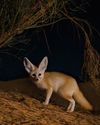BEE LINE
BBC Wildlife
|April 2022
Beautiful and intimate images reveal extraordinary insights into the social structure, communication, defensive strategies and sex lives of wild honeybees

ABOUT THE CONTRIBUTORS
Ingo Arndt and Jürgen Tautz have come together to publish Honey Bees (Natural History Museum, £25). Ingo is an award-winning German nature photographer and more of his work can be seen at ingoarndt.com. Jürgen is a leading bee expert, behavioural scientist, sociobiologist, author and retired professor.
Thirsty work
Like zebras at a waterhole, western honeybees line up at a small pool to collect water. But they aren't simply quenching their thirst: water is used to cool the nest (workers fan their wings to promote evaporation) and dilute the honey that is fed to the older larvae.

Frozen in flight
Keeping her head steady as she prepares to land, this honeybee constantly scans her environment with eyes and antennae sensing touch, taste and smell - enabling her to navigate to food sources and home again.

Hot buzz
Thermal imaging reveals temperature differences between less-active bees (blue), those preparing for take-off (white) and others that are warming the nest (paler orange) vibrating flight muscles to keep it about 35°C.

Home sweet home
A swarm arrives at a tree hollow tagged with a chemical beacon by 'scouts' to guide each bee to its new home. Swarming occurs when a hive becomes too crowded, stimulating the production of new queens. One of these will take over the colony, while the existing queen departs with thousands of her 'subjects' to establish a new nest.
This story is from the April 2022 edition of BBC Wildlife.
Subscribe to Magzter GOLD to access thousands of curated premium stories, and 10,000+ magazines and newspapers.
Already a subscriber? Sign In
MORE STORIES FROM BBC Wildlife

BBC Wildlife
"I was terrified the elephant would ram us"
African elephant in Kenya
2 mins
January 2026

BBC Wildlife
ALL YOU EVER NEEDED TO KNOW ABOUT THE Fennec fox
THE FENNEC FOX IS THE SMALLEST fox in the world, with a body length that can be as little as 24cm.
3 mins
January 2026

BBC Wildlife
INTO THE PLASTISPHERE
A unique synthetic ecosystem is evolving in our oceans – welcome to the plastisphere
7 mins
January 2026

BBC Wildlife
“More than half of all animal life exists in a parasitic relationship, and all life lives in symbiosis”
Our survival depends on species evolving to live together - but some relationships take dark turns
7 mins
January 2026

BBC Wildlife
Are animals able to dream?
SLEEP IS A MYSTERIOUS THING. FOR A long time, we weren't sure why we do it.
1 mins
January 2026

BBC Wildlife
Does a cuckoo know it's a cuckoo?
ABSURD LITTLE BIRDS ACROSS THE world lay their eggs in the nests of other species, leaving the hapless parents to raise a changeling at the expense of their own offspring.
2 mins
January 2026

BBC Wildlife
Orcas killing young sharks
Juvenile great whites are easy prey for orca pod
1 mins
January 2026

BBC Wildlife
Ocean goes on tour
Acclaimed film touring the UK, backed by live orchestra and choir
1 min
January 2026

BBC Wildlife
Feisty bats hunt like lions
Winged mammals use a 'hang and wait' strategy to take down large prey
1 mins
January 2026

BBC Wildlife
SNAP-CHAT
Richard Birchett on magical merlins, wily coyotes and charging deer
2 mins
January 2026
Translate
Change font size

